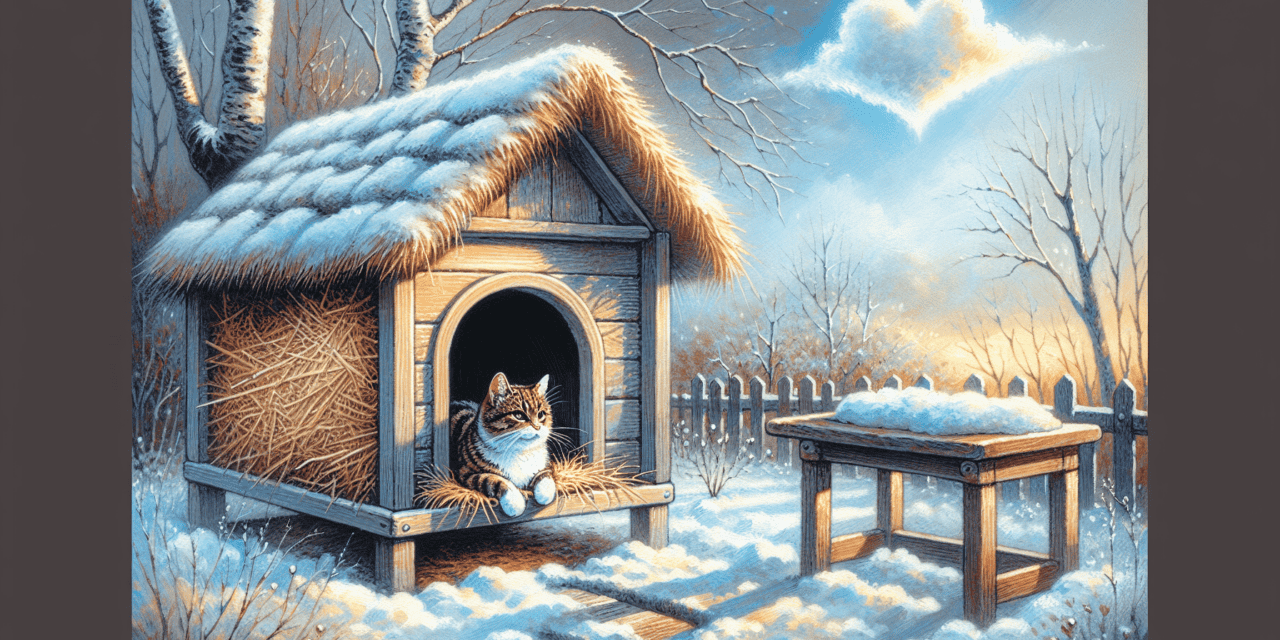As winter approaches, ensuring your feline friends are warm and safe becomes a top priority for cat owners and animal lovers alike. In this comprehensive guide on choosing the perfect outdoor cat house, we will explore essential tips and insights to help you select the best shelter for your outdoor cat. From understanding the features of an ideal cat house for outside to the importance of providing shelter for stray and feral cats, this article covers it all. We will also delve into how to keep your outside cat warm during the chilly months, including insulation options and effective heating solutions. Additionally, we’ll answer common questions such as, “Will a styrofoam cooler keep a cat warm?” and provide DIY outdoor cat house ideas that cater to various needs. Join us as we navigate the world of outdoor cat houses and ensure your furry companions have a cozy retreat this winter.
Choosing the Right Outdoor Cat House
When considering the best shelter for an outdoor cat, it’s essential to prioritize durability, insulation, and ease of construction. An effective outdoor cat house not only provides a safe haven but also protects your feline friend from harsh weather conditions. Here are some effective options to consider for creating a suitable house for cats outside:
- Rubbermaid Roughneck Containers: These plastic storage bins are highly durable and weather-resistant. They can be easily modified to create a cozy shelter for outdoor cats.
- Insulated Styrofoam Shelters: Using large pieces of Styrofoam insulation, you can construct a shelter that provides excellent thermal insulation. Cut the Styrofoam to size and assemble it into a box shape, ensuring that it is well-sealed to prevent moisture ingress.
- Styrofoam Coolers: An alternative to custom-built shelters, Styrofoam coolers can serve as ready-made shelters. They are lightweight, insulated, and can be easily placed in a sheltered area.
- Bedding Material: Regardless of the shelter type, adding straw as bedding is crucial. Straw is an excellent insulator, keeping cats warm during cold weather while allowing moisture to escape. Avoid using blankets or towels, as they can retain moisture and become cold.
- Location and Protection: Position the shelter in a dry, wind-protected area, ideally against a wall or under a porch. This will enhance the shelter’s effectiveness by shielding it from harsh weather conditions.
For more detailed guidance on creating effective shelters for outdoor cats, refer to resources from organizations like the ASPCA and Humane Society, which provide comprehensive insights into feline welfare and outdoor cat management.
Features of an Ideal Cat House for Outside
An ideal cat house for outside should incorporate several key features to ensure the comfort and safety of outdoor cats. Here are the essential elements to consider:
- Insulation: An insulated outdoor cat house is vital for keeping your pet warm during winter months. Look for options that include insulated walls and roofs to maintain a stable temperature.
- Weatherproofing: Ensure that the cat house is waterproof and can withstand various weather conditions. This includes using materials that resist rain and snow, as well as having a sloped roof to prevent water accumulation.
- Size and Space: The cat house should be spacious enough for your cat to move around comfortably. It should also have a small entrance to keep out larger predators while allowing easy access for your feline.
- Ventilation: Proper ventilation is crucial to prevent moisture buildup inside the shelter. Incorporate vents that allow fresh air to circulate while keeping the elements out.
- Accessibility: Make sure that the cat house is easy to access for cleaning and maintenance. A removable roof or side panel can facilitate this process.
By focusing on these features, you can create a safe and comfortable outdoor cat house that will serve your feline friend well throughout the seasons. For DIY enthusiasts, consider exploring outdoor cat house DIY plans to craft a personalized shelter that meets your cat’s needs.

Choosing the Right Outdoor Cat House
When selecting the best shelter for your feline friend, it’s essential to consider various factors that contribute to their comfort and safety. An outdoor cat house should provide adequate protection from the elements while ensuring a cozy environment for your cat. Here are some key aspects to keep in mind:
- Size and Space: The cat house for outside should be spacious enough for your cat to move around comfortably but not so large that it loses heat. A snug fit helps retain warmth during colder months.
- Material: Look for durable, weatherproof materials that can withstand harsh conditions. Insulated outdoor cat houses made from wood or heavy-duty plastic are excellent choices.
- Elevation: An elevated design can prevent moisture from seeping in and protect your cat from ground-level cold. Consider a cat outdoor house with a raised floor.
- Entryway Design: A small entrance helps keep out wind and rain. Flaps or tunnels can provide additional protection from the elements.
Features of an Ideal Cat House for Outside
To ensure your outdoor cat house meets your cat’s needs, consider incorporating the following features:
- Insulation: An insulated outdoor cat house is crucial for maintaining warmth during winter. Look for models with insulated walls and roofs to keep your cat cozy.
- Ventilation: Proper airflow is essential to prevent moisture buildup. Ensure the design allows for ventilation without compromising warmth.
- Easy Access for Cleaning: A removable roof or door can make it easier to clean the house, ensuring a hygienic environment for your cat.
- Heating Options: Consider adding a heated cat house outdoor or an outdoor cat house heater to provide extra warmth during freezing temperatures.
By selecting an appropriate outdoor cat house with these features, you can create a safe and comfortable haven for your feline companion, especially during the colder months. For DIY enthusiasts, there are numerous outdoor cat house DIY plans available online that can help you build a customized shelter tailored to your cat’s needs.
Do Cats Like Outdoor Cat Houses?
Understanding whether cats enjoy outdoor cat houses involves examining their preferences and behaviors. Many felines exhibit a mix of preferences when it comes to indoor versus outdoor living. Outdoor cat houses, often referred to as “catios,” provide a safe space for cats to experience the outdoors while remaining protected from potential dangers such as predators and traffic.
Benefits of Outdoor Cat Houses for Felines
Outdoor cat houses offer numerous benefits that can enhance a cat’s quality of life:
- Safe Exploration: These structures allow cats to engage in natural behaviors like climbing, scratching, and sunbathing while minimizing risks associated with outdoor environments.
- Health Benefits: Exposure to outdoor settings can reduce stress and anxiety in cats, contributing to improved overall health. Research indicates that outdoor access can lead to better mental well-being (McGowan et al., 2014).
- Personality Considerations: A cat’s individual temperament plays a significant role in their enjoyment of outdoor spaces. More adventurous cats may thrive in outdoor cat houses, while shy or timid cats may prefer the safety of indoors.
How to Encourage Cats to Use Their Outdoor House
To ensure that your feline friend enjoys their outdoor cat house, consider the following strategies:
- Supervised Outdoor Time: Allow your cat to explore the outdoors under supervision to gauge their comfort level and gradually acclimate them to the outdoor environment.
- Invest in a Catio: Building or purchasing a catio can provide a secure outdoor experience, allowing your cat to enjoy fresh air without the risks associated with free roaming.
- Monitor Behavior: Pay attention to your cat’s reactions to outdoor environments. Understanding their preferences will help you create a more inviting space.
In conclusion, while many cats can enjoy outdoor cat houses, individual preferences vary widely based on personality and past experiences. Providing a safe outdoor space can enhance their quality of life, aligning with holistic approaches to pet wellness. For more insights into cat behavior and wellness, resources from the American Association of Feline Practitioners can be invaluable.
How Do I Keep My Outside Cat Warm in the Winter?
To keep your outdoor cat warm and safe during winter, consider the following comprehensive strategies:
- Insulated Shelters:
- Construct or purchase insulated cat houses made from materials like wood or plastic. Ensure that these shelters are elevated off the ground to prevent cold air and moisture from seeping in. A raised platform can help maintain a dry and warm environment.
- Use a flap door to minimize wind exposure, and ensure the shelter is small enough to retain body heat but spacious enough for your cat to move comfortably.
- Bedding:
- Line the shelter with straw or hay, as these materials provide excellent insulation and do not retain moisture. Avoid using blankets or towels, as they can become damp and cold, which may lead to hypothermia.
- Consider adding a thermal pet bed or heated pads designed for outdoor use, ensuring they are safe and waterproof.
- Location:
- Place the shelter in a protected area, such as near a wall or under a porch, to shield it from harsh winds and snow. Ensure it is away from heavy foot traffic to provide a quiet retreat for your cat.
- Food and Water:
- Provide high-quality, calorie-dense food to help your cat maintain body heat. Cats require more energy in colder months, so consider feeding them more frequently.
- Use heated water bowls to prevent water from freezing, ensuring your cat stays hydrated.
- Regular Check-ins:
- Monitor your cat’s health and behavior regularly. Look for signs of distress or cold, such as shivering or reluctance to leave the shelter. If temperatures drop significantly, consider bringing your cat indoors during extreme weather.
- Wellness Coaching:
- For ongoing support in caring for your outdoor cat, consider consulting with a wellness coach who specializes in pet care. They can provide tailored advice on nutrition, health monitoring, and environmental enrichment to ensure your cat thrives in winter conditions.
By implementing these strategies, you can significantly enhance your outdoor cat’s comfort and safety during the winter months. For further reading, refer to resources from the ASPCA and the Humane Society, which provide detailed guidelines on caring for outdoor cats in cold weather.
Insulation Options for Outdoor Cat Houses
When it comes to selecting insulation for your outdoor cat house, there are several effective options to consider:
- Foam Board Insulation: This type of insulation is lightweight and easy to install. It can be cut to fit the walls of your cat house, providing a solid barrier against the cold.
- Reflective Insulation: Utilizing reflective materials can help retain heat within the shelter. This type of insulation reflects the cat’s body heat back into the house, keeping it warmer.
- Straw or Hay: As mentioned earlier, these materials not only serve as bedding but also provide natural insulation. They are excellent for keeping the cold at bay while remaining dry.
- Insulated Cat House Kits: Many manufacturers offer pre-made insulated outdoor cat houses that come with built-in insulation. These can be a convenient option for those looking for a quick solution.
Choosing the right insulation for your outdoor cat house is crucial for ensuring your feline friend stays warm during the winter months. For DIY enthusiasts, consider exploring outdoor cat house DIY plans that incorporate effective insulation methods.

Outdoor Cat House Options for Winter
When it comes to providing a safe and comfortable space for our feline friends during the colder months, selecting the right outdoor cat house is crucial. An outdoor cat house not only offers shelter from harsh weather but also ensures that your cat remains warm and secure. Here are some essential options to consider for winter.
Weatherproof Outdoor Cat Shelter Designs
Choosing a weatherproof outdoor cat shelter is vital for protecting your cat from rain, snow, and wind. Look for designs that feature:
- Durable Materials: Opt for materials like treated wood or high-quality plastic that can withstand the elements.
- Elevated Bases: An elevated design helps prevent moisture from seeping in and keeps the interior dry.
- Insulation: Insulated outdoor cat houses are ideal for winter, as they help maintain a stable temperature inside. Consider options with insulated walls and roofs to enhance warmth.
For those interested in DIY projects, creating an outdoor cat house DIY can be a rewarding experience. You can customize the size and features to suit your specific needs, ensuring a perfect fit for your outdoor cat.
Heated Outdoor Cat Houses: A Must for Winter
For added warmth, heated outdoor cat houses are an excellent investment. These shelters often come equipped with:
- Heating Pads: An outdoor heating pad for cats can be placed inside the house to provide a cozy spot for your cat to rest.
- Electric Heaters: Some models feature built-in electric heaters that maintain a comfortable temperature even in freezing conditions.
- Safety Features: Ensure that any heated cat house has safety features, such as chew-proof cords and automatic shut-off mechanisms, to prevent accidents.
By investing in a heated cat house for outside use, you can significantly improve your cat’s comfort during the winter months. Remember, providing a warm and secure shelter is essential for their well-being, especially for outdoor cats and feral populations.
Outdoor Cat House Options for Winter
Weatherproof Outdoor Cat Shelter Designs
When selecting a shelter for your outdoor cat, it’s crucial to prioritize weatherproof designs that can withstand harsh winter conditions. An ideal outdoor cat house should be constructed from durable materials, such as treated wood or heavy-duty plastic, which can resist moisture and prevent drafts. Look for features like slanted roofs to facilitate rain and snow runoff, and elevated bases to keep the house dry from ground moisture.
Additionally, consider insulated outdoor cat houses that provide extra warmth during frigid temperatures. Insulation can be achieved through materials like foam boards or straw, which help maintain a stable internal temperature. For those interested in DIY projects, there are numerous outdoor cat house DIY plans available online that guide you through building a sturdy, insulated shelter tailored to your cat’s needs.
For more information on creating a cozy outdoor space, check out the [ASPCA](https://www.aspca.org/) for tips on building effective shelters for stray and feral cats.
Heated Outdoor Cat Houses: A Must for Winter
In colder climates, heated outdoor cat houses are essential for ensuring your feline friend stays warm and comfortable. These specialized shelters often come equipped with built-in heating pads or can be fitted with outdoor cat house heaters that provide a consistent source of warmth. When selecting a heated cat house for outside use, ensure it is designed specifically for outdoor conditions, featuring waterproof materials and proper insulation.
Consider options like outdoor heated cat houses that include thermal insulation to retain heat effectively. Many models are also energy-efficient, minimizing electricity costs while keeping your cat cozy. If you’re looking for a more budget-friendly solution, you can create a DIY outdoor cat house with heating pads designed for outdoor use, ensuring your cat has a warm refuge during the winter months.
For additional resources on outdoor cat shelters, visit [Petfinder](https://www.petfinder.com/) for a variety of options and tips on keeping outdoor cats safe and warm during winter.
Outdoor Cat House Options for Winter
When it comes to ensuring the comfort and safety of our feline friends during the colder months, selecting the right outdoor cat house is crucial. An outdoor cat house not only provides shelter but also protects cats from harsh winter conditions. Here are some effective options to consider:
Weatherproof Outdoor Cat Shelter Designs
Choosing a weatherproof outdoor cat shelter is essential for keeping your pet safe from rain, snow, and wind. Look for designs that feature:
- Insulated Walls: An insulated outdoor cat house helps maintain a stable temperature, keeping your cat warm even in freezing conditions.
- Elevated Bases: Elevating the shelter off the ground prevents moisture from seeping in and helps keep the interior dry.
- Waterproof Materials: Opt for materials like treated wood or heavy-duty plastic that can withstand the elements.
- Secure Entrances: Ensure the entrance is small enough to retain heat while allowing easy access for your cat.
For those interested in DIY projects, consider creating your own outdoor cat house using plans available online. This allows for customization to fit your specific needs and preferences.
Heated Outdoor Cat Houses: A Must for Winter
Heated outdoor cat houses are an excellent investment for pet owners concerned about their cats’ comfort during winter. These shelters often come equipped with:
- Built-in Heating Pads: Many heated cat houses feature integrated heating pads that provide a warm resting area for your cat.
- Energy Efficiency: Look for models that are energy-efficient to minimize electricity costs while keeping your cat warm.
- Safety Features: Ensure that the heating elements are safe and designed specifically for outdoor use to prevent any hazards.
Brands like ASPCA and Humane Society often recommend heated options for outdoor cat houses, emphasizing their importance in providing a safe haven for outdoor cats during the winter months.












